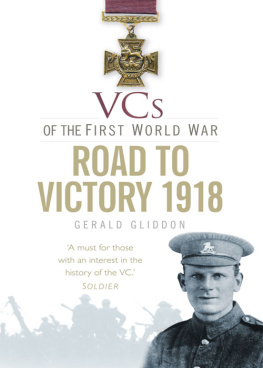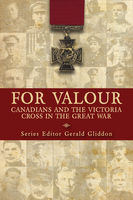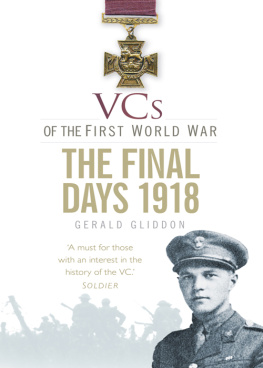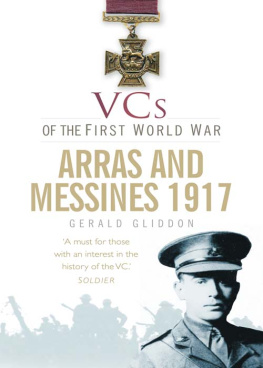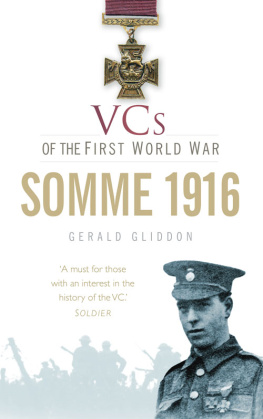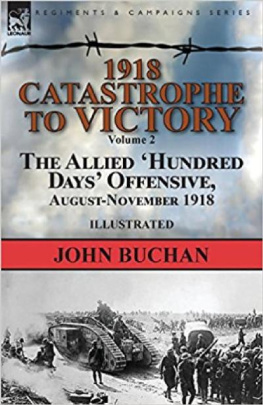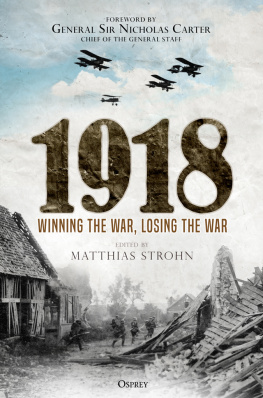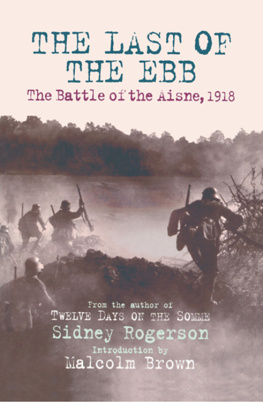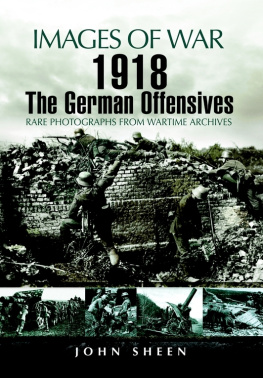I would like to thank the staff of the following institutions for their assistance during the research for this book: the Commonwealth War Graves Commission, the Imperial War Museum, the National Army Museum and the National Archives. In addition, I would like to thank the archivists and curators of the many regimental museums and libraries who have replied to my requests for information.
Where recently taken photographs have been used, their owners have been acknowledged with the individual illustration. As with my previous books in the VCs of the First World War series, Donald C. Jennings of Florida has been very kind in allowing me to reproduce many of the pictures of graves or memorials used in this book. Many of the maps used have been taken from regimental histories or from the British Official History of the War: Military Operations in France and Belgium, 19141918, edited by J.E. Edmonds, Macmillan / HMSO, 192249.
Other individuals who have been of great help in many ways included Peter Batchelor, John Bolton, John Cameron, Jack Cavanagh, Colonel Terry Cave CBE, D.G. Gage, Ray Grover, Peter Harris, Chris Matson, Dick Rayner and Steve Snelling. Other people who provided additional material but whose names are not mentioned here have been acknowledged in the list of sources at the end of the book.
P REFACE TO THE
2014 E DITION
The History Press has decided to reissue the VCs of the First World War series in new editions and I have taken advantage of this decision by revising and updating the texts of the current volume.
Since the initial research for this book was carried out fourteen years ago there has been an increasing interest in and awareness of the stories and lives of the men who were awarded the nations and the Commonwealths highest military honour. Evidence of this can be found in the number of new books being published on the subject; the re-issuing of servicemens records by the National Archives and the accessibility of other records of family history, which are now available via Ancestry, the family history magazine, and from other sources. The Internet has also played a major part although information received using this method should always be verified by cross-checking. Finally, the founding of the Victoria Cross Society in 2002 by Brian Best has encouraged further research and publication of informative articles on the holders of the Victoria Cross.
While this book was being prepared the British Government announced plans for commemorating the First World War centenary from 2014 to 2018. One of the ideas put forward is directly linked with the commemoration of the servicemen who won a Victoria Cross during the Great War. It was decided that for men born in the UK a special paving stone would be installed at an appropriate place in the town or district most associated with them. As for VC winners born abroad, it is hoped that their governments might also take up the paving stone scheme or an act of commemoration in their honour.
In addition, the Commonwealth War Graves Commission has an active programme of placing visitors information panels in cemeteries where VC holders are buried or memorials where they are commemorated.
Gerald Gliddon
November 2013
The previous volume to be published chronologically in this series, VCs of the First World War, was one that dealt with the German spring offensive. The book ended on a note of optimism for the Allies as they prepared for their great counter-blow, which led to the end of the war within a hundred days from the beginnings of their new offensive on 8 August 1918.
The German Army had not exactly given up all hope of winning the war, but after their March offensive had failed to deliver the hoped-for knock-out blow, their leaders must have considered that their best chance of victory had now passed. In addition, American troops and equipment were beginning to contribute substantially to the Allied cause.
The British commander Field Marshal Sir Douglas Haig now firmly believed that the war on the Western Front could be finished by the end of 1918. And this despite it not being long since some members of the British Government and military hierarchy thought the war might drag on until 1920. Whatever reason Haig had given to his detractors in the previous three years as Commander of the British Expeditionary Force, there was no doubt that by the beginning of August 1918 he had acquired a new-found confidence and belief in the ability of the Allied armies to at last push the Germans out of France and Belgium. There is also little doubt that British and Dominion troops had learnt the lessons of the previous four years of relative stalemate and had now mastered the art of dealing with an enemy which was beginning to face manpower and equipment shortages in addition to the beginnings of loss of morale and confidence associated with a losing army.
On 8 August the first blows of the Anglo-French offensive fell on the German Second and Eighteenth Armies to the east of Amiens, and were delivered by General Sir Henry Rawlinsons Fourth Army and the French First Army under General Debeney. Great care was taken to deceive the enemy as to the real whereabouts of the Canadian Corps prior to 8 August, and it was a ruse that appeared to have fooled the enemy. In addition, the Allies now integrated their weaponry of aircraft, artillery, tanks, armoured cars and motorised machine guns. Battlefield communication had also been much improved. In particular the small light tank known as the Whippet was found to be able to work easily with the cavalry when the possibilities of exploitation occurred. The brilliantly executed Allied victory at Hamel in early July, when tanks and infantry combined so successfully, was a glimpse of the future of land warfare. After the initial Allied success on 8 August, the Black Day of the German Army, there was an inevitable slow-down with the planned advance. However, the writing was clearly on the wall for the German Army, as within a few days of the beginning of the new offensive, German representatives made official peace overtures to the Allies via President Woodrow Wilson of the USA.
Although the British Army had a good August it was thought that their French colleagues were not pulling their weight in the operations. The British Third and First Armies entered the campaign on 21 August and at the end of the month the Australian Corps captured the stronghold of Mont St Quentin, the protective gateway to the important town of Pronne, which subsequently fell to the victorious Australians.
A few days later, on 2 September, further to the north, the Canadian Corps achieved astonishing success with their breaking of the heavily defended DrocourtQuant Line known by the enemy as the Wotan Line. In a matter of twelve days the BEF had advanced 14 miles on a front of 28 miles and had also taken more than 45,000 German prisoners. On 4 September the New Zealand Army made an important contribution by forcing another part of the German defensive line, the Canal du Nord. Later in September further north the Second and Fifth Armies made substantial progress between the La Basse Canal and Ypres. All these campaigns were accompanied by considerable heroism and gallantry, resulting in the winning of sixty-four VCs between 8 August and 26 September.
It will not come as a surprise to find that the Canadian and Australian Dominion troops figured very highly in the tally of VCs won in this seven-week period. No fewer than eleven VCs were won in the period 89 August, six more in the fighting for Mont St Quentin and twelve at the time of the fall of the DrocourtQuant Line on 23 September. Another dramatic day was the final day of the Battle of phy, when six more Crosses were won. The following day, on 19 September, the British Army began to approach the Hindenburg Line and a week later they were lined up against it.

